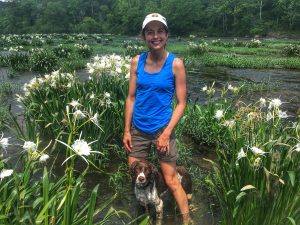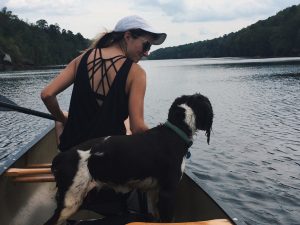Rachel began her work with Alabama Water Watch and the AU Water Resources Center in May 2018, and officially became a full-time Research Associate with us in October 2018. Rachel conducts training workshops, develops new training and educational materials, works on research and grants, and has been instrumental in creating marketing and promotional materials for AWW! She is an AWWesome addition to the AWW Program Staff as she is extremely hard working, intuitive, creative, and a blast to have around the office!
We realize many of you have already communicated with Rachel, but we wanted to officially welcome her to the AWW family by doing a little bit of a Q&A. Read more below to get to know Rachel!
What made you want to work with AWW/AUWRC?
Working with AWW and the AUWRC was appealing to me because it provided ample opportunities to interact with a wide, diverse array of folks: kids and adults, formally-trained scientists and “backyard” naturalists, professors and elementary school teachers, state/federal agencies and citizen-run nonprofits, the list goes on. I wanted to work in a capacity with a university that bridges the gap between academia and research with extension and real-world application. To me, this role captures that.
Lastly, the natural resources and aquatic communities in our state are truly a treasure, and becoming a part of the AWW team is a fantastic way for me to channel my personal passion for Alabama’s outdoor resources.
What past school, research, and work experience helped you prepare for your position here?
My undergraduate at N.C. State University was in the Fisheries and Wildlife program. I was fortunate to have attended a land grant university that had a heavy outdoor/field component. The fisheries portion of my degree involved a blend of coastal and inland fisheries management along with ecology coursework, labs, and field experiences.
I left NC in 2012 to start grad school at Auburn University’s School of Forestry and Wildlife Sciences. My thesis research centered on riparian habitats known as “canebrakes”, which are composed of rivercane, our native bamboo here in the Southeast. My work focused on canebrake restoration and propagation at a macro-scale with field sites in Alabama, Tennessee, and Kentucky.
After finishing my M.S. in 2015, I worked in the forestry industry, more specifically in stream, wetland, and endangered species mitigation as a field biologist. My primary work involved ecological monitoring and land management of private timber properties in Alabama, Mississippi, and northwest Florida. I spent a lot of time along Yellowleaf River, Little Canoe Creek, Locust Fork, Big Sandy, Lost Creek, and the Alabama River during this time.

Rachel sitting next to a gopher tortoise burrow in Mississippi. Gopher tortoises are a keystone species of the longleaf pine ecosystem.
What has been the most challenging part of the job so far?
The transition to spending more time in the office, more specifically, sitting in an office chair. So, I decided to try out a yoga ball as an office chair, and it’s going swimmingly!
What have you liked best?
My absolute favorite parts have been the times I’ve been able to get in the creek for stream biomonitoring practices with workshop attendees or kids for education/outreach events. There is something so special about when someone realizes for the first time how amazing and extraordinary Nature can be. It’s like it was hiding, all this time, right in front of their nose, but now they really see it. That joy and awe is contagious and what motivates me as a natural resources professional.
What is your favorite aquatic critter?
I may be bending the rules a little bit on this one, but I’d have to say the eastern newt (Notophthalmus viridescens) is my favorite. It is such a fascinating creature due to its unique life cycle. It begins life in an aquatic, larval stage, develops into an intermediate, terrestrial stage known as the “red eft” for a few years, and then reverts back to an aquatic adult stage, but unlike most aquatic salamanders, they don’t have gills. To me, the eastern newt represents resilience and flexibility; he’s the guy you would vote for as the “best all around” superlative in high school. Not to mention, it’s so fun to stumble across these little guys in the woods in their red eft stage because they are such a vibrant orange-reddish color that they almost look fake.


